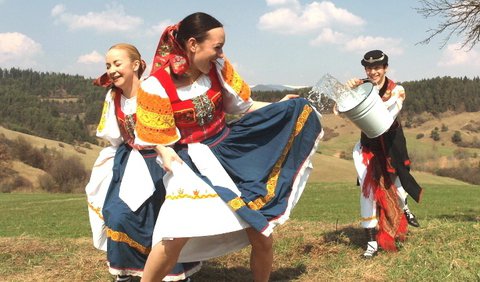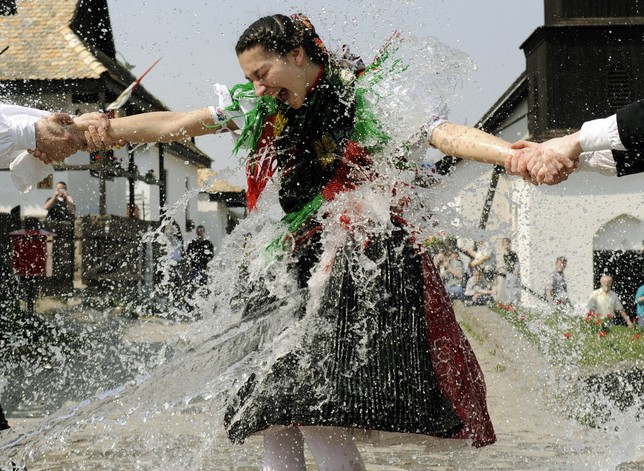We finally took a little extended weekend getaway to Budapest, something we'd been wanting to do for a dog's age. It only takes 2 hours and 40 minutes to get to Budapest from Bratislava by train, and with only a handful of stops, the ride is a breeze.
Neither of us had ever been to Budapest, so it was a totally new experience for both of us. Unfortunately, neither of us speak a word of Hungarian. What was interesting about that is that in the past we've traveled to countries where at least one of us knows the language. When I've been to Italy and France, I could get by okay, since I've studied those languages. Of course when we go to Prague, Terezia does most of the talking, as she was exposed to Czech growing up, and she knows enough German to get by in Vienna. Terezia can also skirt by in Poland, as Polish and Slovaks can kind of understand each other. But in Budapest, the language was truly foreign to both of us. I'll admit it's a slightly odd sounding language if you've never really heard it before. It bears no relation to slavic, germanic, or latin-based languages, and its closest linguistic relatives are Finnish and Estonian. It's somewhat monotone sounding, but also has this soft staccato quality.
Luckily, a lot of people in Budapest (particularly younger generations and restaurant waitstaff) speak English pretty well, and as soon as they could tell we didn't understand Hungarian, they would quickly switch to English. English really is becoming the lingua franca, since we heard Italian, French, and Scandinavian tourists speaking it with the locals. Furthermore, pretty much everyone we dealt with was friendly, so Budapest has got Bratislava beat in the customer service department.
The only language-related snafu occurred when we first got there. The guy we rented the apartment from asked us to text him when we got into town. After getting off the train, hunting for an ATM, then hunting for the nearby metro entrance (which had NO signage what so ever!), and purchasing our metro tickets, we tried texting the owner, only to find that the texts weren't going through. We had a bit of a "duh" moment when we realized that the texts might not have been going through because we were deep in the bowels of the metro system. So, we took the escalator back up, but an army of metro ticket checkers at the top asked for our tickets! The guy who approached us could say "ticket please!" but that was about the extent of his English. Long story short, there was no way in hell I could convey to him our reason for coming back up, so we had to buy new tickets to get back down. Oh well!
The apartment we rented may have been the nicest vacation apartment rental either of us have ever stayed in (and cheap to boot). It was also perfectly and fairly centrally located: a block behind the very cool Great Market (this massive food market housed in a sprawling, beautiful old building), a block from the Danube, and a couple blocks from the lively restaurant strip of Raday Utca. We were in the historical center on the Pest side of the Danube, but not in an overly touristy section of it.
 |
| The apartment building |
 |
| The apartment |
At any rate, how was Budapest? Apart from it being unseasonably hot (around 80 degrees fahrenheit during the day), I've been mulling this over, trying to come up with an apt way to describe the city. To me it feels a bit like a worn and gritty version of Vienna. It has all the grandeur, the massive and goopy art nouveau and liberty style buildings, the pomp, and elegance you'd have expected from a major city in the Austro-Hungarian empire, yet after 40 years of Communist rule (plus 22 years of navigating capitalism with considerable difficulty), there is a worn down patina, a faded splendor, with facades lined and pockmarked with cracks and missing chunks of plaster, and a general roughness around the edges. That dingy Communist-era buildings are interspersed into the urban fabric only adds to that roughness. I've whined about this before, but even though Vienna has loads to offer culturally, aesthetically, it's a little too clean, tidy, and genteel for my tastes, so naturally Budapest appeals more to me.
Not all of it is like that, though. Certain areas, particularly some of the touristy monuments and squares, have been spruced up a lot. But with Hungary being a relatively poor country, they've still got a long way to go before ever reaching the excessive neatness of Vienna.
But overall, the city has a nice feel. More energy than Bratislava or Vienna, yet still more laid-back than other cities. Not as beautiful (architecturally) as Prague, but its grittiness keeps things intriguing. (Also, Budapest appears to be devoid of the uber-tacky tourist shops that plague a couple of Prague's streets). A lot of the locals we encountered seemed to be very "with-it" people, quite in contrast to the extreme right-wing lurch the country's government has taken.
Budapest is a massive and sprawling city (pop. over 2 million), and quite decentralized, which meant that we had to get acquainted with its awesome public transit. There are three metro lines which run in meandering arcs across the city, and while the metro won't get you to every little corner like Paris' metro, it'll get you to most major sights, while the tram handily fills in the links. And like any great city transit system, we rarely had to wait more than four minutes for the next tram or metro to come along. Also, the metro cars are these cool old Soviet-designed clunkers, some of which have groovy, vintage interiors.
 |
| Heading down into the depths of the metro system |
 |
| Terka on the Liberty Bridge |
Budapest's three central bridges that cross the Danube, and the area around them, make for an incredibly scenic river setting. Gellert hill, on the Buda side (by the Liberty Bridge), rises dramatically on its craggy outcropping, covered in lush greenery, capped off with a Soviet monument, with weird, romanesque looking chapel-like structures at its base. The hill just to the south of it is made equally dramatic with the castle, Matyas cathedral, and Fisherman's bastion all clustered on top of it. Although it looks completely different, the overall effect is not unlike gazing at Prague's beautiful riverside setting from Charles Bridge. It's easy to see how the Magyars could've been so taken with the geography of the location that they decided to stop being nomadic and settle there.
 |
| Gellert Hill |
Of course the views out over the city from the Fisherman's Bastion on the castle hill on the Buda side are incredible too.
The Pest side features lots of gently curving streets lined with the aforementioned goopy art nouveau, liberty, and/or historicist styles that were in vogue in the late 1800s/early 1900s. We wandered through these streets quite a bit, especially the atmospheric side streets around Vaci Utca. Vaci is kind of tacky and touristy and avoidable, and as soon as you turn off of it, the vibe does a total 180, and you're back in Budapest again. (We did find a yummy gelateria on Vaci, though.)
One of the coolest things for me was the Parisi Udvar, an old Parisian styled shopping gallery, which is basically a mishmash of liberty style/neo-gothic porn. This is where the Budapest cafe scene from Tinker Tailer Soldier Spy was filmed. Sadly, all of the shop spaces are currently empty, and it's difficult to understand why. This would seem to be prime real-estate (why is it not filled with posh restaurants or swanky clothing boutiques?), but surely there's gotta be some hassle-filled bureaucratic explanation, or very possibly a financial one. Still, I'm glad it's open so that geeks like us can go in and wander around.
The Great Market Hall was incredibly vast, although I have to admit that much of the produce I saw on display was kind of pedestrian. Those mountains of red bell peppers looked nice, but I just didn't see the slightly more exotic things that you can find at Vienna's Naschmarkt (and back home in Oakland) like fresh medjool dates or wild mushrooms like morels or chanterelles (which are in season now). Still, the butcher stands were loaded with tasty-looking treats, and the cheap food-stands upstairs were hopping. We had langos for lunch one day (fried dough with sour cream, garlic, cheese, and whatever else you want), and while they weren't bad, nothing beats the fresh-off-the-skillet variety that we get in Terezia's mom's kitchen.
| The Great Market Hall |
| Inside the Great Market Hall |
| Menza, an uber stylish, vintage-modern restaurant that aims to create a communist-era vibe. |
Speaking of food, Raday utca has about a 4-5 block stretch along which every inch seems to be occupied by restaurants. Raday is reportedly the "hip" restaurant area, where locals still outnumber the tourists (or so I'm told). All of the restaurants have outside patio seating lining both sides of the street, making this pedestrianized strip quite lively. On warm evenings, this feels like the place to be. That it was a mere two blocks away from our apartment was a major bonus. Two of the three dinners we ate here were quite good, featuring things like a rich goose leg confit or duck breast with a spicy Hungarian paprikash.
The Museum of Terror was something I'd been wanting to see for a while. Housed in the actual building used by Hungary's fascist Arrow Cross party's gestapo during WWII, and used by Hungary's secret police during Communism, this museum couldn't be more appropriately located. The most horrifying section of the museum was the basement, which contained actual prison cells. These were, of course, tiny, drab, and totally demoralizing. One cell was just large enough for one slender human to stand up in; I noticed the floor of this one was quite worn! There was also a torture room complete with a stool and a table full of sharp implements and electrodes. In the middle of the floor was a large drain (I read that the building's pipes once actually got clogged up with human blood). A room with a gallows was particularly disturbing.
Overall, it was nice to get out of Bratislava for a bit and experience a totally new (to us) city. Plus, Bratislava is so small that it's refreshing to explore a much larger city. We would definitely go back (next time I want to hike up to the top of Gellert Hill, explore the old Jewish neighborhood, and hell, maybe even check out one of the spas that the city is so famous for), as we both think Budapest is worth getting to know better.
 |
| The Chain Bridge |

















